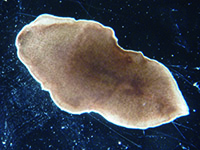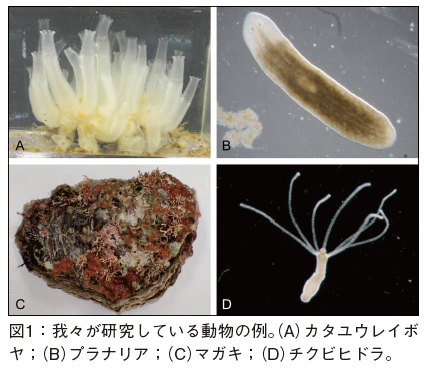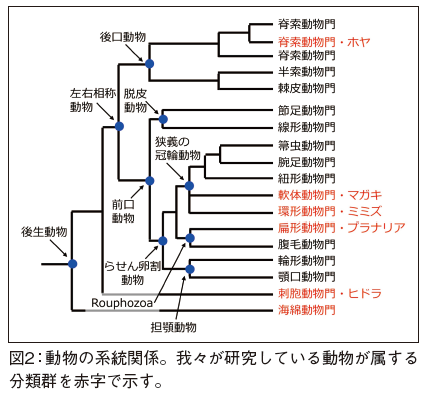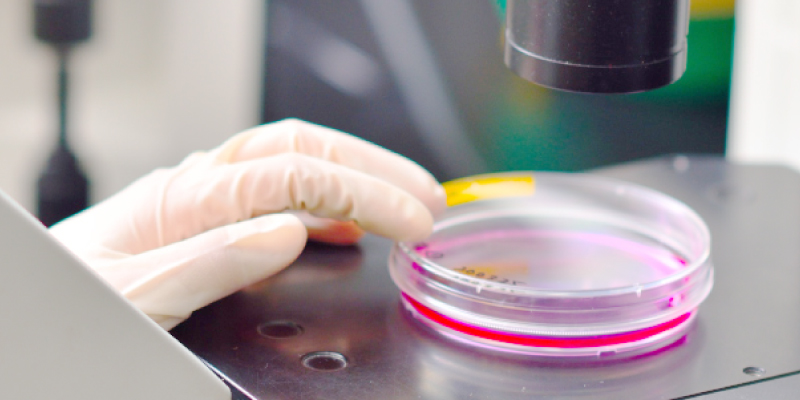
和田 修一
(わだ・しゅういち)
Shuichi Wada
略歴
- 東京都立大学大学院理学研究科博士課程修了
- 独立行政法人科学技術振興機構戦略的創造研究推進事業研究員を経て本学へ
比較動物学研究室

卒業研究テーマ例
- プラナリアのsmall HSPファミリー遺伝子の発現解析
- ミミズにおけるUspAファミリー遺伝子のストレス応答
- ホヤの発生に対する多環芳香族炭化水素の影響の解析
プラナリアの低酸素応答メカニズムの解明
UspAファミリー遺伝子の解析
ホヤの発生におけるヒストン修飾酵素の役割の解明
ホヤの発生に対するPAH 類の影響の解析


- 研究の応用領域
- 動物のストレス応答の解析、ヒストン修飾の制御方法の開発、PAH 類の毒性評価など
- 産官学連携で求めるパートナー
- 研究成果に基づいた実用化の可能性を共に探求できる大学、公的研究機関、企業など
The aim of our research is to understand the diversity of molecular mechanisms involved in animal development and stress response. To that end, we are conducting the following projects using various invertebrates including the ascidian Ciona intestinalis and the planarian Schmidtea mediterranea: (1) Elucidation of hypoxia response mechanism in planarians; (2) Analysis of UspA family genes; (3) Elucidation of the role of histone modifying enzymes during ascidian development; (4) Analysis of influence of PAHs on ascidian development. In addition to these, we are also studying the genetic diversity of animals living in the Lake Biwa and its surrounding areas.
Elucidation of hypoxia response mechanism in planarians
Generally, when animals become hypoxic, the transcription factor HIF1 works to activate the expression of genes necessary for adaptation to hypoxia. This mechanism of hypoxic response is widely conserved in the animal kingdom, but HIF1 and its regulatory factors do not exist in the phylum Platyhelminthes. Therefore, we are trying to unveil a mechanism responsible for hypoxia response in planarians.
Analysis of UspA family genes
The UspA family is a group of stress response-related genes whose function is unknown. UspA family genes are genes of old origin that are shared by Eubacteria, Archaea and Eukaryotes. However, UspA family genes are unevenly distributed in the animal kingdom. They exist in ascidians, spiralians, cnidarians and sponges, but not in chordates other than ascidians and ecdysozoans. We are investigating the nature of UspA family genes in the animal kingdom using animals such as ascidians, planarians, bivalves, earthworms, hydras and so on.
Elucidation of the role of histone modifying enzymes during ascidian development
Modification of histones plays an important role in the regulation of gene expression, but its role in development is largely unclear. Therefore, we are investigating the function of histone modifying enzymes in the development of the ascidian C. intestinalis.
Analysis of influence of PAHs on ascidian development
PAHs (polycyclic aromatic hydrocarbons) are compounds generated in association with the combustion of fossil fuels. Because some PAHs have mutagenic and/or carcinogenic properties, PAHs have been studied as environmental pollutants. The influence of PAHs on vertebrates has been well studied, but few studies investigate the effect on invertebrates. Therefore, we are investigating the toxic effects of PAHs on C. intestinalis embryos and the mechanism of their toxicity.
T. Fujikawa, T. Munakata, S. Kondo, N. Satoh and S. Wada. Stress response in the ascidian Ciona intestinalis: transcriptional profiling of genes for the heat shock protein 70 chaperone system under heat stress and endoplasmic reticulum stress. Cell Stress Chaperones, 15, 193-204 (2010).
S. Wada, M. Hamada, K. Kobayashi and N. Satoh. Novel genes involved in canonical Wnt/beta-catenin signaling pathway in early Ciona intestinalis embryos. Dev. Growth Differ., 50, 215-227 (2008).
Y. Satou, S. Wada, Y. Sasakura and N. Satoh. Regulatory genes in the ancestral chordate genomes. Dev. Genes Evol., 218, 715-721 (2008).
M. Hamada, S. Wada, K. Kobayashi and N. Satoh. Novel genes involved in Ciona intestinalis embryogenesis: characterization of gene knockdown embryos. Dev. Dyn., 236, 1820-1831 (2007).
S. Wada, M. Hamada and N. Satoh. A genomewide analysis of genes for the heat shock protein 70 chaperone system in the ascidian Ciona intestinalis. Cell Stress Chaperones, 11, 23-33 (2006).






